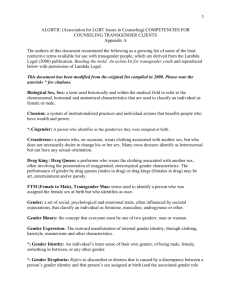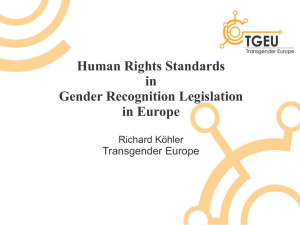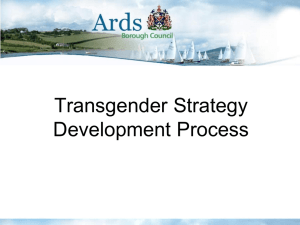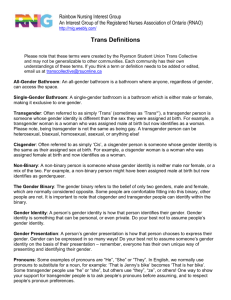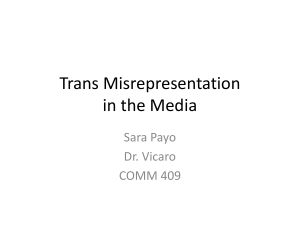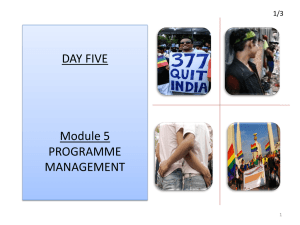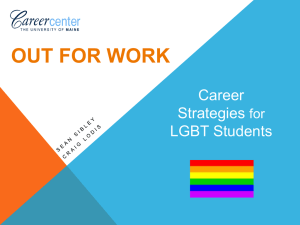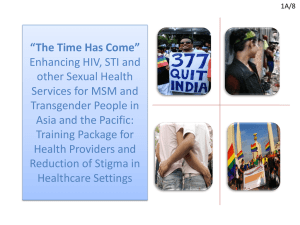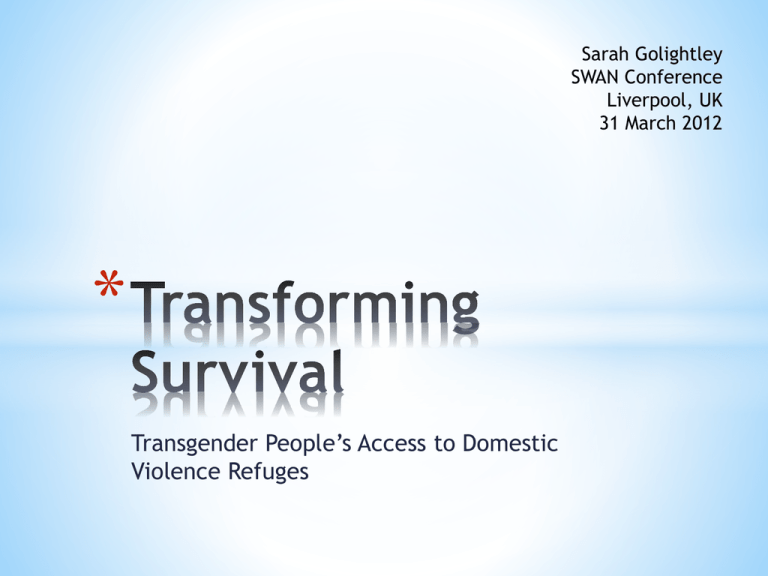
Sarah Golightley
SWAN Conference
Liverpool, UK
31 March 2012
*
Transgender People’s Access to Domestic
Violence Refuges
* If you are a transgender woman do you stay in
the women’s or the men’s refuge?
* If you’re a transgender man where do you go?
* If you don’t identify as either male or female
what are your refuge options?
* Are any of these services safe, supportive, or
accessible to transgender people?
*
“He started with constant verbal abuse, I was
ugly, people knew I was a man, no one would
want me cos' I am a freak, I am not a woman. He
repeatedly forced me to have sex with him,
even though I did not want to as he continued to
threaten my life by either harming me himself
or by exposing my [transgender] status to
people who would not respond well to the
knowledge and seek to hurt me.”
- Sara, a transgender woman survivor (Ceissman
2011, pp.5)
*
*
*
*
*
*
*
*
*
*
*
*
*
‘Outing’ a person’s transgender status
Not allowing a person to be ‘out’
Using the wrong pronouns
Forcing someone to perform a gender they do not wish to present as
Isolating the victim/survivor from LGBT community and friends
Taking advantage of a lack of discrimination protection and housing alternatives
Ridiculing or exotifying their body
Transphobic name calling, or making a person feel guilty, faulty, or ashamed of their gender
Preventing them from gender transitioning (hiding hormones, denying surgery)
Blaming a person for being transgender or for causing the discrimination they have experienced
Sexual or physical touch of a person’s body that does not respect their gender identity or body
comfort
Forced marriage of transgender people to ‘correct’ or hide the person’s gender non-conformity
All types of DV can be experienced by transgender people, this is potentially magnified in its
impact by the effects of transphobia on self-esteem, lack of sensitive support services, and lack
of viable alternatives (i.e. many transgender people are not out to family, friends, religious
communities or are rejected by them once out)
* High rates of mental health problems, substance misuse and homelessness
* More likely to experience harassment and hate crimes
*
*
*
*
*
*
Transgender people, like non-transgender women, are consistent
targets of violence and discrimination
Gender norms are in and of themselves violent – reinforcing
gender roles based on inequality, power and coercion. Sexism and
transphobia are intricately linked ways of regulating ‘acceptable’
gender expressions
Domestic violence can only be fought against when we challenge
violent gender norms, not when we reinforce them through the
exclusion of people with a non-conforming gender identity or
gender expression
Social workers must challenge legislative, systemic, and
interpersonal transphobia and sexism
Domestic violence refuges should proactively create inclusive
services for transgender domestic violence victims/survivors
*
*
*
*
*
*
*
*
*
*
*
Respect a transgender person’s identity- if they say they are a woman, they are a woman.
Use the name and pronoun the victim/survivor identifies with, regardless of legal
documents. If you are unsure of the person’s preferences, then ask.
Do not make assumptions about the gender of the victim/survivor or of their partner/expartner’s gender.
Let the person decide for themselves which gender service they would like to use.
Look at your refuge’s policy towards transgender people- does it even have one? Have a
policy that explicitly includes transgender people and make this inclusion policy publicly
accessible.
Review your intake process and documents, be sure that they use gender inclusive
language. Instead of having questions that ask to tick the box of “male” or “female” this
could change to be open ended, ex. “Gender______”
Like other medical information, do not disclose a person’s gender status to staff or
residents unless you have the person’s permission to do so.
Do not ask the person about the details of their transgender status (ex. NOT appropriate to
ask if they have had surgery or what their genitals look like).
Have a private, individual and gender neutral toilet and washing facility. If possible, a
private sleeping arrangement may be safer and more appropriate for a transgender person.
Address the victim/survivors needs according to what the person considers to be important,
do NOT treat being transgender as the problem.
*
*
Educate staff and residents about transgender people with training and
resources.
* Act swiftly and effectively against transphobia and other forms of
discrimination within the refuge.
*
*
*
*
*
Advertise and display your inclusion towards transgender people on
websites, leaflets, and around the refuge.
Advertise your inclusion policy to transgender organisations, events, and
community media.
Reach out to transgender and LGBT community groups, involve them in
improving your service.
Support transgender community initiatives, promote visibility of positive
transgender relationships and the many successes of transgender people.
Promote transgender and LGBT specific domestic violence initiatives,
including the creation of an LGBT DV refuge. This is what LGBT service
users say that they want most.
*
* Questions, resources, comments or feedback?

